Marsha C. Salett and Mark Faherty
With an emphasis on fall shorebird migration
Introduction
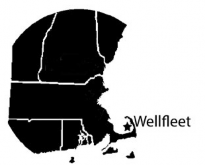 One of the most diverse and beautiful places to bird on Cape Cod, Mass Audubon’s Wellfleet Bay Wildlife Sanctuary (WBWS) offers excellent birding throughout the year, particularly during the shorebird show from mid-July to the end of September. At least 291 species have been recorded here according to eBird, making it the most speciose eBird Hotspot on Cape Cod. The sanctuary also has attracted a long list of rarities over the years, including Spotted Redshank (1990), Black-tailed Godwit (1994), Chuck-will’s-widow (1996), Mississippi Kite (at least three records), Golden Eagle (2008), Fork-tailed Flycatcher (2009), American Avocet, Black-necked Stilt, Scissor-tailed Flycatcher, and Lazuli Bunting (2012).
One of the most diverse and beautiful places to bird on Cape Cod, Mass Audubon’s Wellfleet Bay Wildlife Sanctuary (WBWS) offers excellent birding throughout the year, particularly during the shorebird show from mid-July to the end of September. At least 291 species have been recorded here according to eBird, making it the most speciose eBird Hotspot on Cape Cod. The sanctuary also has attracted a long list of rarities over the years, including Spotted Redshank (1990), Black-tailed Godwit (1994), Chuck-will’s-widow (1996), Mississippi Kite (at least three records), Golden Eagle (2008), Fork-tailed Flycatcher (2009), American Avocet, Black-necked Stilt, Scissor-tailed Flycatcher, and Lazuli Bunting (2012).
In 1958, Mass Audubon bought the original 366-acre property from the Austin Ornithological Research Station, one of the largest private bird banding stations in the world in its heyday. Today Wellfleet Bay Wildlife Sanctuary has grown to more than 1100 protected acres of varied habitats for birds and other wildlife, including salt marsh, barrier beach, extensive tidal flats, brackish and freshwater ponds and creeks, pitch pine and scrub oak woods, coastal heathland, and sandplain grassland. Five miles of trails wind through the sanctuary, providing interest to birders, botanists, and nature lovers in general. Admission is free to Mass Audubon members. For nonmembers, the fee is $5.00 for adults and $3.00 for children (2-12) and seniors (65+).
The Esther Underwood Johnson Nature Center has been awarded a Platinum LEED rating for its green technology and sustainable building features. It contains classrooms, exhibits, a green building “trail,” a gift shop, and an area for feeder watching—an especially warm spot in winter. The Nature Center is open daily Memorial Day through Columbus Day from 8:30 am to 5:00 pm, and open Tuesday through Sunday Columbus Day–Memorial Day from 8:30 am to 5:00 pm. Trails are open daily 8:00 am to dusk.
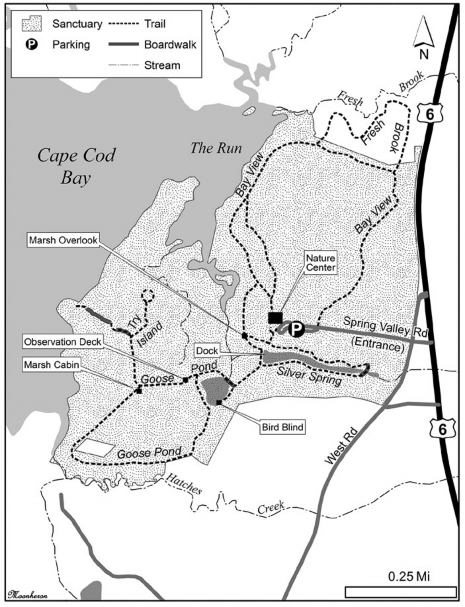
Wellfleet Bay has a universally accessible, multi-sensory interpretive trail that overlays the Robert R. Read All-Persons Pathway and Goose Pond Trail and is approximately one-quarter mile long from the Nature Center to a boardwalk at Goose Pond. You can download the Accessible Trails Booklets and the Sensory Trail’s audio tour to play on your iPod or other MP3 player. During Nature Center hours, you can borrow an MP3 player at WBWS, copies of the trail map in printed or tactile formats, and copies of a printed or Braille guide. Exploring the All-Persons Pathway, the Nature Center, and the parking lot, birders of all abilities can enjoy Wellfleet Bay Wildlife Sanctuary.
WBWS opened a bird banding station in 2014 for the first time since the 1980s. Banding will begin again in 2016 with weekly demonstrations each Saturday morning from early September through mid-November. Demonstrations in spring run from late April through the end of May.
Tides and Timing
At WBWS—and most places on the Cape—the best time to bird the beaches and flats is on an incoming mid tide, one to three hours after low tide, or on a dropping tide, as birds fly in to feed on the recently exposed flats. For an outgoing tide, two to four hours after the high tide is most productive. The birds are concentrated closer to the beach and trails, and you can still see shorebirds roosting and feeding in the salt marsh. More importantly, the highest full moon or storm tides flood the trail and boardwalk to the beach. Before you begin your walk, check the tide charts. There’s one in the Nature Center to the right of the door leading out to the trails, and another chart outdoors on a post near the beginning of the Goose Pond Trail. On 10- to 12-foot tides, the trail is flooded at high tide, but it also may be wet on mid to low tides.
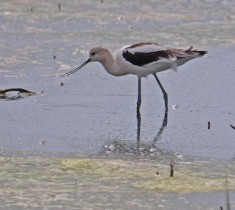
American Avocet. All photographs by Richard Johnson.
On a sunny beach day you’ll find few other visitors on the trails, but on a cloudy cool day the sanctuary gets quite crowded and finding a parking space is difficult. Plan to arrive early. When it is busy, ask the trail naturalists to point you toward the least traveled trails. They can also inform you of current rarities.
Fall shorebird migration begins around mid-July with the arrival of Short-billed Dowitchers, Whimbrels, and Semipalmated and Least sandpipers, and it peaks during the entire month of August, winding down in late September. The following walk for an optimal birding day in August at WBWS assumes a low tide between 6:00–7:00 am, but you can adjust for the tide by changing the order of how you walk the trails. Birding can be good at all tides, so don’t worry if your trip does not align with this itinerary. Plan on arriving at the sanctuary when it opens at 8:00 am and staying for either the entire morning or most of the day. You can bring lunch to eat at the picnic tables.
Parking Lot and Nature Center
When you drive up to the parking area, check the nest boxes in the field to your right for Eastern Bluebirds—resident year-round—and Tree Swallows. In spring and summer a Purple Martin gourd rack is present, which was donated by the Birdwatcher’s General Store in Orleans in 2014. As of this writing the gourds have attracted only a few scouts, mainly young males, with none yet staying to nest. The tall nest pole in the back of the field has yet to attract an Osprey, but Red-tailed Hawks, Eastern Bluebirds, Northern Flickers, and many other species use it. Judging from pellets found underneath the pole, the Great Horned Owls that usually nest in the campground woods like to use it on occasion (one such pellet consisted entirely of striped skunk fur). Spend a couple of minutes in the parking lot to look for Cedar Waxwings, Gray Catbirds, Eastern Towhees, Baltimore Orioles, and Wild Turkeys near the photovoltaic array.
In the spring and fall, the parking lot is one of the best spots for warblers and other migrants: Yellow-rumps and Ruby-crowned Kinglets in April, then Northern Parulas, Nashville, Yellow, Chestnut-sided, Magnolia, Black-throated Blue, Black-throated Green, Black-and-white, and American Redstarts, along with Blue-gray Gnatcatchers, and Blue-headed and Red-eyed vireos. If thrushes are around they are likely to be in the picnic area just off the parking lot. October is the time to find Yellow-bellied Sapsuckers in the parking lot elms, and the sanctuary may be the most reliable spot on the Cape for this species. Winter brings flocks of robins and waxwings and the occasional vagrant: Bohemian Waxwings, redpolls, and both crossbills have been here during irruption years.
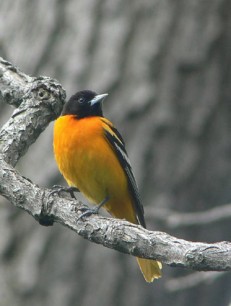
Baltimore Orioles frequent the jelly feeder at the Nature Center.
Head toward the Nature Center. If you arrive before it opens at 8:30 am, go through the gate near the butterfly garden to access the trails. Around the Nature Center and at the beginning of the Goose Pond Trail, you’ll find the common resident species: Black-capped Chickadees, Tufted Titmice, Red-breasted and White-breasted nuthatches (both species are year-round here), Song Sparrows, Chipping Sparrows, Northern Cardinals, House Finches, and American Goldfinches. Jelly feeders in the butterfly garden attract Baltimore and Orchard orioles and Gray Catbirds; Ruby-throated Hummingbirds dart to and from the nectar feeders and often perch on bare twigs in the big elm above the garden. The garden’s native wildflowers attract many butterflies, including American ladies, spicebush swallowtails, coral and banded hairstreaks, dun and silver-spotted skippers, monarchs, and Leonard’s skipper in fall.
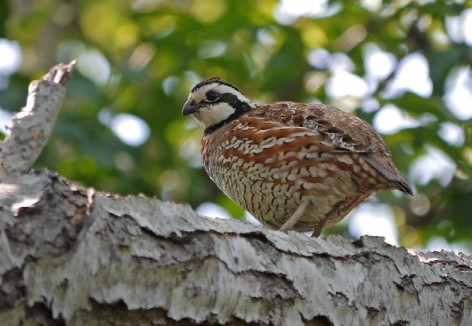
Northern Bobwhite.
It is worthwhile to check out the feeders at the Nature Center before and after you walk the trails. The Lazuli Bunting was spotted here in February of 2012. In winter, there can be up to seven sparrow species at one time: Field, Song, White-throated, Fox, Dark-eyed Junco, Swamp, and American Tree, with White-crowned often seen during October. In summer, the mix includes Eastern Towhee and Chipping Sparrow. Of late, the feeders attract Wild Turkeys in addition to the resident passerines, but the Northern Bobwhites that once visited the feeders have not been seen or heard since 2012. Purple Finches and Pine Siskins are often seen at the feeders in October, and Rusty and even Yellow-headed blackbirds have made appearances, as have Brown Thrashers several times.
Goose Pond Trail
Follow the Goose Pond Trail past the photovoltaic array, but instead of bearing left, detour straight ahead to the split rail fence at the marsh overlook. Scan the salt marsh for American Black Ducks and Mallards, Greater Yellowlegs, Least Sandpipers, and Great and Snowy egrets. If you visit the sanctuary within a day or two of a late August full moon, you may witness the phenomenon when the tide is so high that it floods the entire marsh, and dozens of Laughing Gulls bob in the water and fly overhead, calling loudly. Listen for nesting Orchard and Baltimore orioles, Pine Warblers, American Goldfinches, Red-bellied Woodpeckers, Black-capped Chickadees, Tufted Titmice, and both nuthatch species in the nearby pitch pines. Retrace your steps, then turn right onto the Goose Pond Trail.
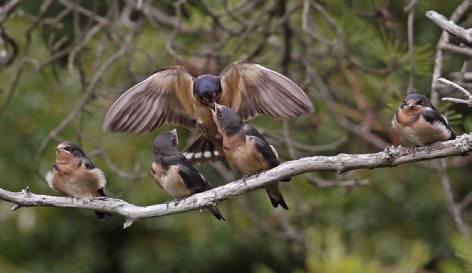
Barn Swallows.
Another short and productive detour is the dock at Silver Spring. Look for Belted Kingfishers and Eastern Phoebes overhead and Gray Catbirds, Red-winged Blackbirds, Common Grackles, and again, both orioles in the trees (Orchards typically nest somewhere over the dock) or bathing in the shallows to your left. Recently fledged Barn and Tree swallows perch on snags and overhanging branches and hawk for insects over the water early in the season. Listen for Fish Crows overhead, and scan the trees for Green Herons and juvenile Yellow-crowned Night-Herons later in the summer. Black-crowned is also possible, but Yellow-crowned has been the default late summer night-heron in recent years.
From the dock, you may also see painted turtles, bullfrogs, and green frogs. Common dragonflies at Silver Spring include slaty skimmers, blue dashers, and eastern amberwings; damselflies include eastern and fragile forktails and bluets. For butterflies, look for broad-winged skippers nectaring on the pickerelweed and water willow in July and August.
Back on the trail, scan the marsh opposite Silver Spring from the dike. The cattails right below you can host Virginia Rail, Swamp Sparrow, and the occasional Marsh Wren in migration. Clapper Rails are occasional in the salt marsh beyond but only detectable when they are calling. A Short-eared Owl did a flyby here in October of 2009.
Continuing on the Goose Pond Trail, you will pass through a tract of dead and dying red pines and spruces. Many of these European red pines that Dr. Austin planted in the 1930s have succumbed to old age or infestations of native insects, rendering this section of the property a haven for woodpeckers and other cavity nesters. Native pitch pines, white pines, and oaks are beginning to transform this woodland. Downy and Hairy woodpeckers, Blue Jays, Black-capped Chickadees, and White-breasted Nuthatches are common here. You will also hear Common Yellowthroats calling from the edge of the marsh here (and all along the Goose Pond and Bay View trails). In winter, this is a good spot for Golden-crowned Kinglets.
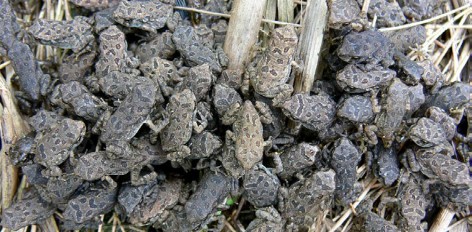
Fowler's Toads.
Goose Pond is where much of the shorebird migration action is, especially when the mudflats are exposed in late summer and when high tides cover the feeding flats out by the beach. The show is varied and variable from week to week: Green Herons, Great and Snowy egrets, and Belted Kingfishers may be perched on snags in the pond or in the surrounding trees. The herons and egrets may be hunting in the water and you’ll often hear the rattling call of kingfishers overhead. With your scope, scan the shore of the entire pond for young Yellow-crowned or Black-crowned night-herons, and the back for Spotted and Solitary sandpipers. Northern Waterthrushes are annual in July and August and can be seen walking the perimeter. The most common shorebirds are Semipalmated Plovers, Greater and Lesser yellowlegs, and Semipalmated and Least sandpipers; less common visitors include Western, White-rumped, and Pectoral sandpipers. Stilt Sandpipers have been seen here multiple times in the past few years. Both Wilson’s Phalarope and a Hudsonian Godwit visited in September of 2014, providing rare point-blank views of both species as they fed at nearly arm’s length.
Mallards and American Black Ducks—sometimes hybrids—and their ducklings paddle around in June and July. Red-winged Blackbirds nest in the phragmites and Eastern Phoebes hawk insects there. Remember to look up now and then for a Red-tailed, Cooper’s or Sharp-shinned hawk, Merlin, or Peregrine Falcon. The raptors will sometimes perch on the top of the large eastern cedar next to the bench. In winter, Cedar Waxwings gorge on its fruit.
Goose Pond is also a nursery for Fowler’s toads and many species of fish, including mummichogs, killifish, and sheepshead minnows. Looking straight down into the water from the railing, you’ll often see them schooling in the shallows. When dry-downs occur in late summer and trap the fish in ever shrinking pools, egrets and shorebirds sometimes concentrate right below the bridge offering staggeringly close looks. You may also see painted and snapping turtles and the occasional muskrat here.
Before moving on, scan the salt marsh right across from Goose Pond for sandpipers, and scope farther out for egrets, night-herons, Great Blue Herons, and infrequent Glossy Ibis.
The pitch pine and scrub oak habitat of the trail is where you’ll find Great-crested Flycatchers, Blue Jays, American Robins, Northern Cardinals, and American Goldfinches. Cedar Waxwings and Green Herons have occasionally nested in the pitch pines in this area. The sanctuary’s first fisher, a mammal that has colonized Cape Cod only during the last ten years, was spotted resting in a tree right here in 2014. Where the Goose Pond Trail forks to the left, keep going straight.
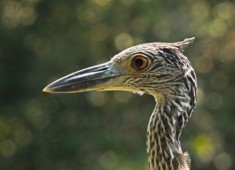
Yellow-crowned Night-Heron.
The trees begin to thin out at the observation platform, which provides a pretty view of Cape Cod Bay, the salt marsh, and Try Island. Scope the pans for Snowy Egrets, both yellowlegs, and Willets. Walking from the platform toward the marsh cabin, look and listen for breeding Prairie Warblers, Eastern Kingbirds, Field Sparrows, Eastern Bluebirds, and Eastern Towhees, especially in the restored heathland on your left (spring and summer). Woodcocks display in the heathland on spring evenings. In case they recolonize from the surrounding areas, listen for Northern Bobwhites in spring and summer.
When you arrive at a T-intersection, you’ll be facing the wide expanse of salt marsh and Cape Cod Bay. Before you turn right to head toward the beach, spend a few moments near the bench. This sandy spot is one of the best places on the sanctuary to watch fiddler crabs—favorite food of Whimbrels—scurrying around or darting into their burrows in the sand. If the water is lapping at the foot of the bench or the tidal creek is too wide to ford easily, you’ll know that the trail to the beach is inundated; but it shouldn’t be at most low tides.
Try Island
Instead of going straight to the beach, turn right onto the Try Island Trail, which is just past the tidal creek. This is one of the most interesting trails for birders and botanists, with a spectacular panoramic view over the salt marsh, beach, and bay. Try Island, a true island in Cape Cod Bay a couple of hundred years ago, was the site of a “try works” where settlers would render whale blubber into oil. Now it is an upland remnant of Southern hardwood forest— including mockernut hickory, white oak, and sassafras—in the midst of the salt marsh. This section of marsh between the Try Island and beach trails can be one of the only places to find Northern Mockingbirds on the sanctuary and is a good place for Prairie Warblers and Eastern Bluebirds. Listen and look here for Field, Song, Savannah, and Saltmarsh sparrows. Eastern Kingbirds, Tree Swallows, and American Goldfinches are common in the salt marsh all along the Try Island Trail. American Robins, American Crows, and Eastern Towhees are common in the upland forest. Historically, Brown Thrashers and Black-billed Cuckoos occurred on Try Island.
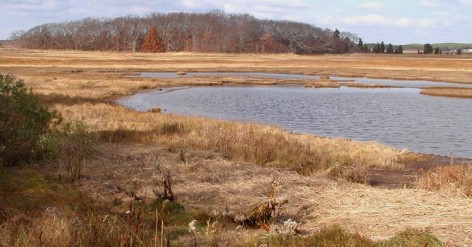
Try Island.
At the top of the rise, the trail bears left, but detour to the right to the overlook. Pan your scope slowly across the marsh. Although they don’t breed here, Great Blue Herons gather in the marsh in summer and fall. When the tide is high, the grass hides dozens of Whimbrels. Whimbrels spend their days feeding on fiddler crabs at Wellfleet Bay then return to Monomoy Island, a presumed night roost that was confirmed by a satellite-tracked juvenile Whimbrel in 2015. When the tide is lower, scan the pans and creek banks for Whimbrels, Willets, Greater and Lesser yellowlegs, and smaller shorebirds. Watch for Ospreys overhead and Northern Harriers cruising over the salt marsh. American Crows and Ring-billed, Herring, and Great Black-backed gulls are common in the marsh.
Continue along the Try Island loop. At the bench, take in the view of the beach and the bay. This west-facing bench is one of the best places to enjoy gorgeous sunsets any time of year. As you walk downhill, the trail becomes sandier and vegetation transitions to eastern red cedar, beach plum, poverty grass (Hudsonia), and goldenrods. Cedar Waxwings, Northern Cardinals, and finches are attracted to this spot.
By now, you’ve probably noticed several wire exclosures in the sand. These contain diamondback terrapin nests, many of which are concentrated in open, soft sand turtle gardens. Terrapin volunteers walk the sanctuary a couple of times a day in June when the terrapins lay their eggs so that they can find the nests and protect them from predators. In August, the volunteers are back on the trails monitoring the nests in order to free the hatchlings from the exclosures and take them to the nature center to be weighed and measured—and monitored for a few days if necessary—before releasing them back to the wild. For more information about diamondback terrapins, inquire at the nature center. If you’re lucky enough, you might see a volunteer along the trail with some newly hatched terrapins.
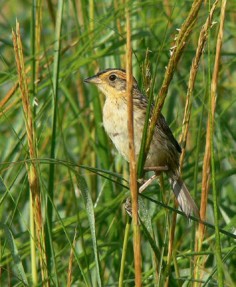
Saltmarsh Sparrow.
Boardwalks
Follow the two boardwalks out to the beach. The boardwalks are also a fine place to watch the fiddler crabs. Willets breed in the marsh to the left. In June and July through early August when they are raising young, you can’t miss them; they’ll be wheeling above the marsh, screeching their wil-wil-willet calls. For the rest of the summer they quietly move to the salt pans or the edge of the water. Far more subtle are the sparrows: mostly Song, but also Savannah, and in some years Saltmarsh. These boardwalks are probably the best place at the sanctuary to find Saltmarsh Sparrows. Listen for Clapper Rails here as well.
The several patches of bare ground in the marsh are the result of salt marsh dieback, likely the result of overgrazing by the nocturnal square-backed marsh crab combined with stress from sea level rise affecting the regrowth of the marsh grasses. The bare spots will pool up with the rising tide. Around low to mid tide, you may find Semipalmated Plovers, Willets, an occasional Whimbrel, or even a Ruddy Turnstone.
Overhead, Tree Swallows hawk for insects most of the summer. You’ll get some of the closest views of Tree Swallows at WBWS halfway down the second boardwalk. Early in the summer, look for a few Barn Swallows among them; look for Rough-winged and Bank swallows later in the season.
The Beach
You’ve arrived at the beach. The creek straight ahead is Hatches Creek; the barrier beach behind it and to the left is South Sunken Meadow Beach. If you arrive at low tide, the tidal flats extend out half a mile or more to Cape Cod Bay. At high tide, the run covers the flats entirely, the creek rises, and there is no way to navigate by foot between the sanctuary beach and South Sunken Meadow. Ideally, your timing is perfect on an incoming tide: most of the flats are covered, there’s a wide peninsula of beach at Sunken Meadow, and Hatch’s Creek is shallow but well defined and flowing inland.
Tree Swallows rest on Sunken Meadow Beach throughout the summer. Scope the beach behind them, where you might find nesting Piping Plovers in June and July. With a lot of patience, you may also spot a plover on the sand. By August, when the young have fledged, the Piping Plovers occasionally feed on this side of the creek. You’ll find a few Greater Yellowlegs and Willets in the water at low tide; as the tide rises, they’re joined at water’s edge by Short-billed Dowitchers, Semipalmated Plovers, Semipalmated, Least, and Spotted sandpipers, and an occasional Ruddy Turnstone. American Oystercatchers and Black Skimmers can be irregular visitors to the beach. The skimmers, mainly juveniles, have appeared in early July as well as in late August.
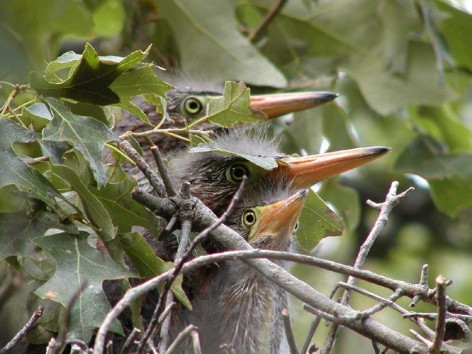
Green Herons.
Look briefly beyond the bench on your left for Horned Larks and Song and Savannah sparrows. Most of the action will be to your right toward Fresh Brook, which is tidal. Lieutenant Island is behind it, and you can see Great Island in the distance to the west. When Fresh Brook is a wide ribbon of mud or only inches deep, it is full of birds: American Black Ducks, Mallards, Brant (winter), Double-crested Cormorants, Great Blue Herons, Great and Snowy egrets, Black-bellied and Semipalmated plovers, Greater and Lesser yellowlegs, Willets, Whimbrels, Short-billed Dowitchers, and Semipalmated and Least sandpipers. There are a handful of records of Baird’s and one of Buff-breasted Sandpiper at the beach, but they are certainly not expected. American Golden-Plover is possible in late summer. Set up your scope on the sand at the edge of the marsh; please do not walk through the salt marsh. As the tide comes in, smaller shorebirds will move up into the mudflats closer to the sand.
Laughing Gulls (spring and summer), Ringed-billed Gulls, Herring Gulls, and Great Black-backed Gulls are common in and along Fresh Brook and the beach. They concentrate on the narrowing sand peninsulas as the tide rises, joined in late summer by roosting Common Terns, Forster’s Terns, and an occasional Roseate Tern. Earlier in the summer, breeding Least Terns fly over the marsh regularly. In late summer, you might see jaegers and shearwaters, mainly Cory’s in recent years, from the beach. As summer turns to fall, Forster’s Terns can become common and are the default tern in October. The high count here was an impressive 243 in October of 2012, though more typical maxima are in the range of a couple dozen.
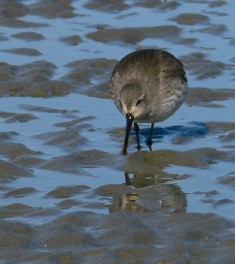
Dunlin.
Scan the marsh behind the beach for Great Blue Herons and egrets if you didn’t do so on Try Island. Bird your way back to the Goose Pond Trail and marsh cabin. Check the vegetation in front of and next to the half-hidden cabin for passerines, including Eastern Kingbird and Prairie Warbler. A Red-tailed Hawk or a crow may tee up on the tallest cedar. If you are running out of time, or the day is hot and humid, turn left and head back toward the Nature Center. If you want a longer walk, follow the back loop of the Goose Pond Trail. It is less traveled than the main trail to the beach, and you’ll have a good chance at finding Eastern Bluebirds, goldfinches, and sparrows. When Purple Finches breed on the sanctuary, it is usually in the red cedar groves along this trail. When you reach the woods behind Goose Pond, if you hear an agitated flock of crows, look in their direction to see if they are mobbing a hawk, a Great Horned Owl, or even a fisher. A Scissor-tailed Flycatcher made an appearance on this less-visited trail in November of 2012.
Stop at Goose Pond again because a couple of hours can make a big difference. Before you get back to the Nature Center, there’ll be one more trail to explore.
Silver Spring
Turn right onto the Silver Spring trail and head into the pine woods. This side of Silver Spring is good for Downy, Hairy, and Red-bellied woodpeckers along with Northern Flickers and Great-crested Flycatchers. From the hill, you can make out the long thin shape of this freshwater pond below. Scan the snags on the opposite shore of Silver Spring for Green Herons and juvenile Black-crowned and Yellow-crowned night-herons.
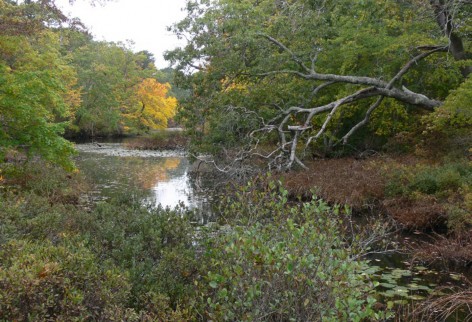
Silver Spring.
When you get to the bridge, check the lily pads for Spotted and Solitary sandpipers in migration, listen for warblers during fall and spring, and watch for river otters or muskrats paddling by. In fall and winter, you might find Black Ducks, Mallards, and Hooded Mergansers. Without fail, up to three Hooded Mergansers mysteriously turn up in Silver Spring every July, a season when this species is rare on the Cape. The fruiting black tupelos along the bank to the east were a favorite feeding spot for the Fork-tailed Flycatcher that visited the sanctuary in September of 2009.
Once you cross the bridge, the habitat changes from conifers to mature oaks, black locusts, and tall shrubs. During the summer, it is quiet except for robins and catbirds, but in the spring and fall, this side of the Silver Spring Trail is an excellent place for warblers and other migrating songbirds: American Redstart, Magnolia Warbler, Northern Parula, Black-throated Green, Blackpoll, Northern Waterthrush, and others are expected, and goodies like Mourning Warbler are occasional. Scarlet and sometimes Summer tanagers are possible as well. When birding for warblers, take the Silver Spring Trail early and first, reversing the direction from this walk, and then head down to Goose Pond, Try Island, and the beach. Be warned that during bird banding season, the section of the Silver Spring trail closest to the visitor center is closed to walkers until about 11:30 am, but it is still possible to hike most of the trail, including the bridge and much of the best warbler habitat on the north side, and then double back. Check with the front desk before you head out.
By the time you get back to the Nature Center, it is probably midday. There’s one more major trail worthy of birding that you might want to explore after lunch or save for another day.
Bay View Trail
The shorter loop of the Bay View Trail covers one mile and takes you through several natural communities: salt marsh, black cherry/locust woodland, coastal heath, and sandplain grassland, as well as offering spectacular views of the sanctuary marshes and Cape Cod Bay beyond. On calm, cool days, you can sometimes hear the moaning of the hauled-out gray seals on Jeremy Point, 3.5 miles to the west across Wellfleet Bay. You can add another half mile to your walk by following the Fresh Brook Pathway along the tidal brook and through the pitch pine woods. Especially when there are a lot of visitors, it is a quieter alternative to the Goose Pond Trail and the beach, and you should encounter the bird species that you would find on other trails. This trail is shadier and cooler in the summer, and tends to shield you from the wind in winter.
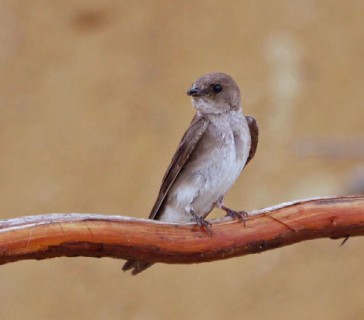
Northern Rough-winged Swallow.
To hike the Bay View trail, start by heading down the Goose Pond Trail to the marsh overlook, and scan the tidal creeks. The salt pans are important feeding and staging habitat for migrating shorebirds. Scan the marsh for Willets, Greater and Lesser yellowlegs, and the small sandpipers, along with egrets and, rarely, Glossy Ibis.
Turn right onto the Bay View Trail. Some of the pitch pines here are about 100 years old and attract year-round residents such as Downy Woodpeckers, Black-capped Chickadees, Tufted Titmice, White-breasted and Red-breasted nuthatches, and American Goldfinches. The pine habitat abruptly changes as you enter the black cherry/black locust/oak grove known to sanctuary staff as the maze. This woodland is historically underbirded and can hold some nice migrants in fall and spring. Bird banding in spring of 2016 produced species such as Hooded and Canada warblers, Lincoln’s Sparrow, and Gray-cheeked Thrush from this woodland. In September and October, you can easily pish up warblers and vireos here, where they are drawn to the many fruiting Virginia creeper vines, among other fruiting trees and shrubs.
When you get to a fork in the trail, take a left and follow the locust grove through a transition zone of smooth sumac and other shrubs that opens up to a field on the right and open views of the marsh on your left. At the bench that faces Try Island, scan the creeks and muddy pans for Mallards and American Black ducks, Snowy and Great egrets, gulls, and shorebirds. In winter, check the barrier beaches beyond the marshes for Snowy Owls during irruption years. Tree and Barn swallows and Eastern Kingbirds hunt insects over the marsh. Northern Harriers fly low over the marsh hunting meadow voles and other small animals in fall and winter; Turkey Vultures and Osprey soar high overhead in spring and summer.
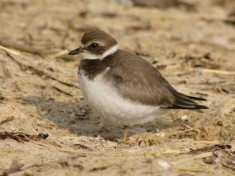
Semipalmated Plover.
Continue on to the open expanse of Fresh Brook Bay. During the hours of low water, the marsh is a maze of tidal creeks, salt pans, and sand flats; at high tide, it may look like a sea of grass. Mass Audubon and the Town of Wellfleet own the open land across the marsh on Lieutenant Island and on the far side of Fresh Brook. The south side of Lieutenant Island can host a nice diversity and number of shorebirds, including during May, when hard to find species like White-rumped Sandpiper, Whimbrel, and even Red Knot may show up among the more expected Dunlin, Ruddy Turnstones, and Black-bellied Plovers. In summer and early fall, hundreds to thousands of migrating shorebirds stop here to rest and feed: Semipalmated and Black-bellied plovers—look for the occasional American Golden Plover—Whimbrels, Greater and Lesser yellowlegs, Willets, Semipalmated, Least, and uncommon Western sandpipers. Laughing Gulls and Common and Forster’s terns stage here, roosting and feeding in the marsh grass and creeks.
In winter, the salt marsh and Fresh Brook Bay are home to large groups of ducks and geese: hundreds of Brant (which sometimes stay through mid-May) are typical, along with Canada Geese, American Black Ducks, Mallards, Common Eider, Bufflehead, and Red-breasted Mergansers. Loons and gannets, and sometimes shearwaters and jaegers, can be seen from the beach in the appropriate seasons.
When you are ready to leave the marsh, look for the signpost that marks the trail junction. Turn right to continue on the shorter of the Bay View Trail loops back to the Nature Center. For a longer walk, you have two options: a detour along the Fresh Brook Pathway that returns to the Bay View Trail or the long Bay View Trail Loop for a walk in the pitch pine barrens.
Taking the shorter loop, you will emerge from the pitch pine barrens into the coastal heathland and sandplain grassland. From the top of this ridge, there is a breathtaking view of the salt marsh, barrier beach, Fresh Brook, and Cape Cod Bay.
The bird boxes in the field are dominated by Tree Swallows, but Eastern Bluebirds also nest in these boxes. The larger box was put up to attract American Kestrels, which last nested in 2009. Kestrels may be extirpated from the Outer Cape. During the day, this field is a favorite cruising ground for Northern Harriers, Cooper’s and Sharp-shinned hawks (both nest at the sanctuary) and Redtails, and at night for Great Horned Owls. In 2006, a Barn Owl unexpectedly turned up in the nets here during a saw-whet banding demonstration. In the spring, American Woodcocks display in the field and even the parking lot; they nest in the field and surrounding thicket. Check the shrub thickets on the right side of the field for breeding Field and Song sparrows as well as Eastern Kingbirds, Eastern Phoebes, and occasionally Brown Thrashers.
To return to the Nature Center, please follow the trail to the right, turn left at the intersection at the locust grove, retrace your steps along the Bay View Trail to the marsh overlook, then left up the trail to the entrance of the building.
You can find directions to Wellfleet Bay on the Mass Audubon website. Online maps and GPS units may not give accurate directions, so please use these directions. For your convenience, they are printed below:
From Boston: Follow Route 3 South and cross the Sagamore Bridge to Cape Cod. Follow Route 6 East for 45 miles. The sanctuary entrance is on the left just over the Wellfleet/Eastham town line after the Wellfleet Drive-in Theater.
From Providence: Follow Interstate 195 or Interstate 495 to Route 25 and cross the Bourne Bridge to Cape Cod. Turn off the Bourne Rotary at the exit for Route 6 East. Continue on Route 6 for 50 miles. The sanctuary entrance is on the left just over the Wellfleet/Eastham town line after the Wellfleet Drive-in Theater.
From Provincetown: Take Route 6 West to South Wellfleet. The sanctuary entrance is on the right just before the Wellfleet Drive-in Theater.
By public transportation: Public Transportation is available through the Cape Cod Regional Transport Authority (CCRTA). For information regarding standard bus routes near the sanctuary or to request a b-bus for door-to-door service, call (800) 352-7155 or visit: www.capecodrta.org.
Mark Faherty has been the science coordinator at Mass Audubon’s Wellfleet Bay Wildlife Sanctuary since August 2007 and has led birding trips for Mass Audubon since 2002. While his current projects involve everything from oysters and horseshoe crabs to bats and butterflies, he has studied primarily bird ecology for the last 20 years, working on research projects in Kenya, Florida, Texas, California, Arizona, Mexico, and the Pacific Northwest. Mark has led birding trips to Panama and Belize for Mass Audubon. He grew up in Brockton and Plymouth and started birding at age six.
Marsha C. Salett is editor of Bird Observer, a writer, and an environmental educator. She has been a teacher/naturalist at Mass Audubon’s Broadmoor Wildlife Sanctuary for over 25 years and has been a volunteer trail naturalist at Wellfleet Bay Wildlife Sanctuary for about 20 summers. Marsha wrote the All-Persons Sensory Trail audio guides for Broadmoor and for Wellfleet Bay.